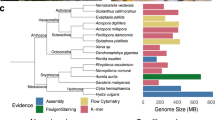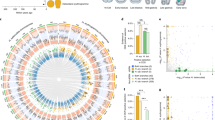Summary
The organization and maternal expression of histone genes differ greatly between the two echinoderm classes represented by the sea stars and sea urchins. We have isolated and characterized a 5.3-kb genomic DNA fragment encoding core histone genes in the sea starPisaster ochraceus. The majority of histone genes are organized as tandem repeats of the 5.3-kb fragment, which is present in as many as 700 copies per haploid genome. The identity, precise location, and transcriptional polarity of individual core histone genes within the repeat were determined by DNA sequence analyses. The gene order in the sea star (H2B, H2A, H4, H3) is different from that in sea urchins (H2B, H3, H2A, H4). What is remarkable is the low level of maternal histone mRNA inP. ochraceus eggs relative to that in sea urchins. This observation supports a recent suggestion that major changes in mode of gene expression, rather than in gene organization or copy number, can be correlated with major events in echinoderm evolution.
Similar content being viewed by others
References
Benton WD, Davis RW (1977) Screening λgt recombinant clones by hybridization to single plaques in situ. Science 196:180–182
Blin N, Stafford DW (1976) A general method for isolation of high molecular weight DNA from eukaryotes. Nucleic Acids Res 3:2303–2308
Bolivar F, Rodriguez RL, Greene PJ, Betlach MC, Heyneker HL, Boyer HW (1977) Construction and characterization of new cloning vehicles. Gene 2:95–113
Britten RJ, Graham DE, Neufeld BR (1974) Analysis of repeating DNA sequences by reassociation. Methods Enzymol 29E:363–418
Childs G, Maxson R, Kedes L (1977) Histone gene expression during sea urchin embryogenesis: isolation and characterization of early and late messenger RNAs ofStrongylocentrotus purpuratus by gene specific hybridization and template activity. Dev Biol 73:153–178
Clerc RG, Bucher P, Strub K, Birnstiel ML (1983) Transcription of a clonedXenopus laevis H4 histone gene in the homologous frog oocyte system depends on an evolutionary conserved sequence motif in the-50 region. Nucleic Acids Res 11:8641–8657
Cohn RH, Kedes L (1979) Nonallelic histone gene clusters of individual sea urchin (Lytechinus pictus): polarity and gene organization. Cell 18:843–853
Cool D (1983) Evolution of a specific cloned repeat DNA sequence in sea stars. MSc thesis, Simon Fraser University, Burnaby, British Columbia, Canada
Crain WR Jr, Durica DS, Van Doren K (1981) Actin gene expression in developing sea urchin embryos. Mol Cell Biol 1:711–720
Davis RW, Botstein D, Roth JR (1980) A manual for genetic engineering: advanced bacterial genetics. Cold Spring Harbor Laboratory, Cold Spring Harbor, New York
Deeley RG, Gordon JI, Burns ATH, Mullinix KP, Binastein M, Goldberger RF (1977) Primary activation of the vitellogenin gene in the rooster. J Biol Chem 252:8310–8319
Fraser A, Gomez J, Hartwick EB, Smith MJ (1981) Observations on the reproduction and development ofPisaster ochraceus (Brandt). Can J Zool 59:1700–1707
Glisin V, Crkvenjakov R, Byus C (1974) Ribonucleic acid isolated by cesium chloride centrifugation. Biochemistry 13:2633–2637
Grunstein M, Diamond KE, Knoppel E, Grunstein JE (1981) Comparison of the early histone H4 gene sequence ofS. purpuratus with maternal, early and late H4 mRNA sequences. Biochemistry 20:1216–1223
Hanly SM, Bleecker GC, Heintz N (1985) Identification of promoter elements necessary for transcriptional regulation of a human histone H4 gene in vitro. Mol Cell Biol 5:380–389
Harvey RP, Robins AJ, Wells JRE (1982) Independently evolving chicken H2B genes: identification of a ubiquitous H2B specific 5′ element. Nucleic Acids Res 10:7851–7863
Hentschel CC, Birnstiel ML (1981) The organization and expression of histone gene families. Cell 25:301–313
Isenberg I (1979) Histones. Annu Rev Biochem 48:159–191
Kedes L (1979) Histone genes and histone messages. Annu Rev Biochem 48:837–870
Kovesdi I (1985) Molecular studies of gene expression in development of the sea starPisaster ochraceus (Brandt). PhD thesis, Simon Fraser University, Burnaby, British Columbia, Canada
Kovesdi I, Smith MJ (1982) Sequence complexity in the maternal RNA of the starfishPisaster ochraceus (Brandt). Dev Biol 89:56–63
Kovesdi I, Smith MJ (1985) Quantitative assessment of action transcripts in eggs, embryos and tube feet of the sea star,P. ochraceus. Mol Cell Biol 5:3001–3008
Kovesdi I, Preugschat F, Stuerzl M, Smith MJ (1984) Genomic and cDNA clones of actin genes from the sea starPisaster ochraceus. Biochim Biophys Acta 782:76–86
Laskey RA, Mills AD (1977) Enhanced radiographic detection of32P and125I using intensifying screens and hypersensitized films. FEBS Lett 82:314–316
Lehrach H, Diamond D, Wozney JM, Boedtker H (1977) RNA molecular weight determinations by gel electrophoresis under denaturing conditions: a critical examination. Biochemistry 16:4743–4751
Maniatis T, Hardison RC, Lacy E, Lauer J, O'Connell C, Quon D, Kim GK, Efstratiadis A (1978) The isolation of structural genes from libraries of eukaryotic DNA. Cell 15:687–701
Maniatis T, Fritsch EF, Sambrook J (1982) Molecular cloning: a laboratory manual. Cold Spring Harbor Laboratory, Cold Spring Harbor, New York
Mauron A, Kedes L, Hough-Evans BR, Davidson EH (1982) Accumulation of individual histone mRNAs during embryogenesis of the sea urchinStrongylocentrotus purpuratus. Dev Biol 94:425–434
Maxam AM, Gilbert W (1980) Sequencing end-labeled DNA with base-specific chemical cleavages. Methods Enzymol 65:499–560
Maxson RE, Wilt T (1982) Accumulation of the early histone messenger RNA during the development ofStrongylocentrotus purpuratus. Dev Biol 94:435–450
McDonnell MW, Simon MN, Studier FW (1977) Analysis of restriction fragments of T7 DNA and determination of molecular weight by electrophoresis in neutral and alkaline gels. J Mol Biol 110:119–146
McMaster GK, Carmichael GG (1977) Analysis of single and double-stranded nucleic acids on polyacrylamide and agarose gels by using glyoxal and acridine orange. Proc Natl Acad Sci USA 74:4835–4838
Messing J, Vieira J (1982) A new pair of M13 vectors for selecting either strand of double-digest restriction fragments. Gene 19:269–276
Newrock KM, Cohen LH, Hendricks MB, Donnelly RJ, Weinberg ES (1978) Stage-specific mRNAs coding for subtypes of H2A and H2B histones in the sea urchin embryo. Cell 14:327–336
Old RW, Woodland HR (1984) Histone genes: not so simple after all. Cell 38:624–626
Paul CRC (1977) Evolution of primitive echinoderms. In: Hallam A (ed) Patterns of evolution illustrated by the fossil record. Elsevier, Amsterdam, pp 123–158
Pearson W, Davidson EH, Britten RJ (1977) Program for least squares analyses of reassociation and hybridization data. Nucleic Acids Res 4:1727–1737
Perry M, Thomsen GH, Roeder RG (1985) Genomic organization and sequence of two distinct histone gene clusters fromX. laevis. J Mol Biol 185:479–499
Raff R, Kaufman TC (1983) Embryos, genes, and evolution: the developmental-genetic basis of evolutionary change. Macmillan, New York
Raff RA, Anstrom JA, Huffman CJ, Leaf DS, Loo J-H., Showman RM, Wells DE (1984) Origin of a gene regulatory mechanism in the evolution of echinoderms. Nature 310:312–314
Rigby PW, Dieckman M, Rhodes C, Berg P (1977) Labelling DNA to high specific activity in vitro by nick translation with DNA polymerase I. J Mol Biol 113:237–251
Sanger F, Nicklen S, Coulson AR (1977) DNA sequencing with chain terminating inhibitors. Proc Natl Acad Sci USA 74:5463–5467
Schaffner W, Kunz G, Daetwyler H, Telford J, Smith HO, Birnstiel ML (1978) Genes and spacers of cloned sea urchin histone DNA analyzed by sequencing. Cell 14:655–671
Shott RJ, Lee JJ, Britten RJ, Davidson EH (1984) Differential expression of the actin gene family ofStrongylocentrotus purpuratus. Dev Biol 101:295–306
Smith MJ, Nicholson R, Stuerzl M, Lui A (1982) Single copy DNA homology in sea stars. J Mol Evol 18:92–101
Southern EM (1975) Detection of specific sequences among DNA fragments separated by gel electrophoresis. J Mol Biol 98:503–517
Sugarman BJ, Dodgson J, Engel JD (1983) Genomic organization, DNA sequence and expression of chicken embryonic histone genes. J Biol Chem 258:9005–9016
Sures I, Lowry J, Kedes LH (1978) The DNA sequence of sea urchin (S. purpuratus) H2A, H2B and H3 histone coding and spacer regions. Cell 15:1033–1044
Thayer RE (1979) An improved method for detecting foreig DNA in plasmids ofE. coli. Anal Biochem 98:60–63
Thomas PS (1980) Hybridization of denatured RNA and small DNA fragments transferred to nitrocellulose. Proc Natl Acad Sci USA 77:5201–5205
Zernik M, Heintz N, Boime I, Roeder RG (1980)Xenopus laevis histone genes: Variant H1 genes are present in different clusters. Cell 22:807–815
Author information
Authors and Affiliations
Rights and permissions
About this article
Cite this article
Howell, A.M., Cool, D., Hewitt, J. et al. Organization and unusual expression of histone genes in the sea starPisaster ochraceus . J Mol Evol 25, 29–36 (1987). https://doi.org/10.1007/BF02100038
Received:
Accepted:
Issue Date:
DOI: https://doi.org/10.1007/BF02100038




